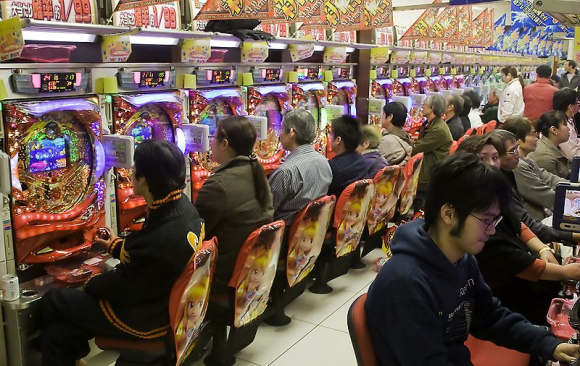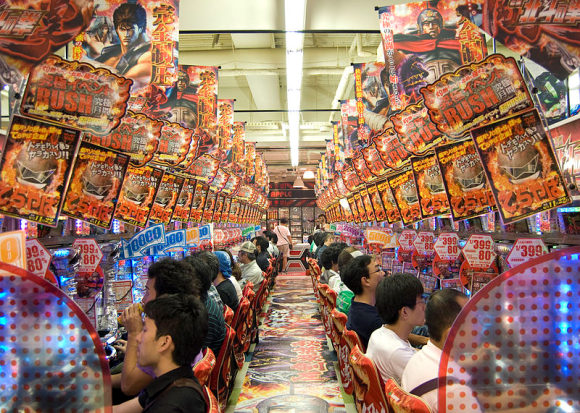
For a country that doesn’t have any businesses officially classified as “casinos,” Japan has a ton of places to gamble. By far the most common are pachinko parlors, which you can find within a short walk of just about every major train station in Tokyo and Japan’s other large cities.
But with so many places to gamble, and many of them allowing customers to purchase the balls used to play for as little as one yen (less than a penny) each, it’s easy to get sucked into the siren song of the pachinko parlor. Seeking to help gamblers keep their wagers within their limits, one company is now proposing using facial recognition software to inform you, or your family, when you’re gambling too much.
At this year’s Pachinko and Pachislot Innovation Fair, held at Tokyo’s Big Sight convention center, pachinko equipment manufacturers showed off their newest products and ideas. One exhibitor, Omron Amusement, was there to talk about its innovative way of utilizing facial recognition software.
As information technology becomes more precise and cost-effective, many pachinko parlors have been installing facial recognition software and cameras, which serve a two-fold purpose. While most pachinko parlors are respectable, safe centers of entertainment for adults, they do sometimes attract certain seedy elements, and facial recognition systems can be useful in identifying and tracking criminals and unruly visitors. Facial recognition software is also used in business research to help pachinko parlor operators analyze which customer demographics are the most profitable.
But Omron Amusement’s idea isn’t about accelerating the pace in which gamblers leave their cash behind, but instead figuring out when it’d be better to put the brakes on it. The company’s proposal would work with Ma:sus, a facial recognition system already installed in many pachinko parlors. Omron says an individual gambler could register his face with the system, which would recognize him as he enters the parlor. From there, it’s a simple matter to calculate the frequency and length of the gambler’s visits.
The key to the system, though, is also registering the individual’s email address. Once that’s done, the system will automatically send a warning email cautioning against spending too much time at the pachinko parlor if the gambler goes over designated limits. Omron says it could have the system ready for interested businesses within the year.
Of course, many addicts, regardless of what their particular vice is, are under the impression that they could stop any time they want to. As such, it doesn’t seem like sending an email to Mr. Tanaka saying, “You’ve been at the pachinko parlor every day this week,” is going to stop him if he really does have a gambling problem. That’s why Omron says the system could also be configured to send the warning email to the gambler’s family members, instead.
Ostensibly, Omron expects families to then rush to their local pachinko parlor and retrieve their relative. We say, though, that’s it’s better to offer any and all related services, so how much would Omron charge to pick up the degenerate gambler and deliver him so relatives can browbeat him in the comfort of their own home?
Source: RBB Today via Jin
Top image: Wikipeda/MichaelMaggs
Insert image: Wikipedia/Tischbeinahe


 Is pachinko headed for extinction in Japan? Studies reveal huge drop in players, hall operators
Is pachinko headed for extinction in Japan? Studies reveal huge drop in players, hall operators Nearly five percent of Japanese are addicted to gambling – even though it’s still “illegal”
Nearly five percent of Japanese are addicted to gambling – even though it’s still “illegal” Angry customer smashes pachinko machines with hammer 【Video】
Angry customer smashes pachinko machines with hammer 【Video】 Pachinko parlor worker lists the three worst types of customers in Japan’s gambling dens
Pachinko parlor worker lists the three worst types of customers in Japan’s gambling dens Why have no COVID-19 clusters occurred in pachinko parlors?
Why have no COVID-19 clusters occurred in pachinko parlors? McDonald’s new Happy Meals offer up cute and practical Sanrio lifestyle goods
McDonald’s new Happy Meals offer up cute and practical Sanrio lifestyle goods All-you-can-drink Starbucks and amazing views part of Tokyo’s new 170 meter-high sky lounge
All-you-can-drink Starbucks and amazing views part of Tokyo’s new 170 meter-high sky lounge Studio Ghibli glasses cases let anime characters keep an eye on your spectacles
Studio Ghibli glasses cases let anime characters keep an eye on your spectacles Kyoto’s 100 Demons yokai monster parade returns!
Kyoto’s 100 Demons yokai monster parade returns! Starbucks reopens at Shibuya Scramble Crossing with new look and design concept
Starbucks reopens at Shibuya Scramble Crossing with new look and design concept Beautiful Sailor Moon manhole cover coasters being given out for free by Tokyo tourist center
Beautiful Sailor Moon manhole cover coasters being given out for free by Tokyo tourist center More foreign tourists than ever before in history visited Japan last month
More foreign tourists than ever before in history visited Japan last month Hey, Japanese taxi driver! Take us to your favorite restaurant in Tsuruga City!
Hey, Japanese taxi driver! Take us to your favorite restaurant in Tsuruga City! The Straw Hat Students are back with a new One Piece Japanese high school anime short【Video】
The Straw Hat Students are back with a new One Piece Japanese high school anime short【Video】 Japanese granny busts a move on the streets of Tokyo 【Video】
Japanese granny busts a move on the streets of Tokyo 【Video】 Disney princesses get official manga makeovers for Manga Princess Cafe opening in Tokyo
Disney princesses get official manga makeovers for Manga Princess Cafe opening in Tokyo Beautiful new Final Fantasy T-shirt collection on the way from Uniqlo【Photos】
Beautiful new Final Fantasy T-shirt collection on the way from Uniqlo【Photos】 Is the new Shinkansen Train Desk ticket worth it?
Is the new Shinkansen Train Desk ticket worth it? Foreign English teachers in Japan pick their favorite Japanese-language phrases【Survey】
Foreign English teachers in Japan pick their favorite Japanese-language phrases【Survey】 Japanese convenience store packs a whole bento into an onigiri rice ball
Japanese convenience store packs a whole bento into an onigiri rice ball We try out “Chan Ramen”, an underground type of ramen popular in the ramen community
We try out “Chan Ramen”, an underground type of ramen popular in the ramen community Studio Ghibli releases Kiki’s Delivery Service chocolate cake pouches in Japan
Studio Ghibli releases Kiki’s Delivery Service chocolate cake pouches in Japan Japan’s bone-breaking and record-breaking roller coaster is permanently shutting down
Japan’s bone-breaking and record-breaking roller coaster is permanently shutting down New definition of “Japanese whiskey” goes into effect to prevent fakes from fooling overseas buyers
New definition of “Japanese whiskey” goes into effect to prevent fakes from fooling overseas buyers Our Japanese reporter visits Costco in the U.S., finds super American and very Japanese things
Our Japanese reporter visits Costco in the U.S., finds super American and very Japanese things Studio Ghibli unveils Mother’s Day gift set that captures the love in My Neighbour Totoro
Studio Ghibli unveils Mother’s Day gift set that captures the love in My Neighbour Totoro Foreign passenger shoves conductor on one of the last full runs for Japan’s Thunderbird train
Foreign passenger shoves conductor on one of the last full runs for Japan’s Thunderbird train Domino’s Japan now sells…pizza ears?
Domino’s Japan now sells…pizza ears? New Japanese KitKat flavour stars Sanrio characters, including Hello Kitty
New Japanese KitKat flavour stars Sanrio characters, including Hello Kitty Kyoto creates new for-tourist buses to address overtourism with higher prices, faster rides
Kyoto creates new for-tourist buses to address overtourism with higher prices, faster rides Sales of Japan’s most convenient train ticket/shopping payment cards suspended indefinitely
Sales of Japan’s most convenient train ticket/shopping payment cards suspended indefinitely Sold-out Studio Ghibli desktop humidifiers are back so Totoro can help you through the dry season
Sold-out Studio Ghibli desktop humidifiers are back so Totoro can help you through the dry season Japanese government to make first change to romanization spelling rules since the 1950s
Japanese government to make first change to romanization spelling rules since the 1950s Ghibli founders Toshio Suzuki and Hayao Miyazaki contribute to Japanese whisky Totoro label design
Ghibli founders Toshio Suzuki and Hayao Miyazaki contribute to Japanese whisky Totoro label design Doraemon found buried at sea as scene from 1993 anime becomes real life【Photos】
Doraemon found buried at sea as scene from 1993 anime becomes real life【Photos】 Tokyo’s most famous Starbucks is closed
Tokyo’s most famous Starbucks is closed One Piece characters’ nationalities revealed, but fans have mixed opinions
One Piece characters’ nationalities revealed, but fans have mixed opinions We asked a Uniqlo employee what four things we should buy and their suggestions didn’t disappoint
We asked a Uniqlo employee what four things we should buy and their suggestions didn’t disappoint Princesses, fruits, and blacksmiths: Study reveals the 30 most unusual family names in Japan
Princesses, fruits, and blacksmiths: Study reveals the 30 most unusual family names in Japan Number of pachinko parlors in Japan decreasing rapidly, down 12 percent in two years
Number of pachinko parlors in Japan decreasing rapidly, down 12 percent in two years Slot machine’s proposed logo suspiciously familiar to a classic video game
Slot machine’s proposed logo suspiciously familiar to a classic video game Trial begins in the case of Mario Kart v. Mari Car
Trial begins in the case of Mario Kart v. Mari Car 23 people arrested in Aichi for operating and using illegal casino during coronavirus lockdown
23 people arrested in Aichi for operating and using illegal casino during coronavirus lockdown Check out the one-month electric bills for Tokyo Tower, Skytree and more!
Check out the one-month electric bills for Tokyo Tower, Skytree and more! Japanese train operator scraps plan to identify past offenders with facial recognition camera
Japanese train operator scraps plan to identify past offenders with facial recognition camera Chinese man wins 1.8 billion yen from betting on Japanese horse races — what’s his secret?
Chinese man wins 1.8 billion yen from betting on Japanese horse races — what’s his secret? Security guard arrested in Shizuoka for abandoning 13 liters of urine at pachinko parlor
Security guard arrested in Shizuoka for abandoning 13 liters of urine at pachinko parlor Smartphone app finds empty restroom stalls in Tokyo subway station, makes pooing easier than ever
Smartphone app finds empty restroom stalls in Tokyo subway station, makes pooing easier than ever Man tries something unique to appease the pachinko gods –- totally worth it?
Man tries something unique to appease the pachinko gods –- totally worth it? Voice of Evangelion’s main character sad to see how often he gets left out of anime group shots
Voice of Evangelion’s main character sad to see how often he gets left out of anime group shots Real fashion police: Con man arrested in Tokyo, police tipped off by ill-fitting suit
Real fashion police: Con man arrested in Tokyo, police tipped off by ill-fitting suit Man gives up on life and travels 1,000 miles on stolen bikes, incredible journey ends with his arrest
Man gives up on life and travels 1,000 miles on stolen bikes, incredible journey ends with his arrest Osaka man wipes away millions in owed taxes by deducting losing horse race tickets
Osaka man wipes away millions in owed taxes by deducting losing horse race tickets Is the year-end Arashi Concert about to go high-tech with facial recognition for attendees?
Is the year-end Arashi Concert about to go high-tech with facial recognition for attendees? Evangelion theme song lyricist talks about her annual royalties, buying caves in Turkey
Evangelion theme song lyricist talks about her annual royalties, buying caves in Turkey
Leave a Reply